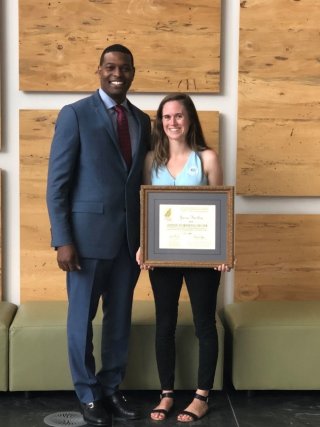From Teacher to Author: How Climate Literacy Guided My Career
When the United States Global Change Research Program released its first Climate Literacy Guide in 2009, I taught an Earth & Environmental Science class at a high school in New York. We were wrapping up our unit on climate change and I spoke with the students about small changes we could make to reduce waste. I asked, "...So what if we all consumed a little less? What if we shopped less, drove less, and tried to alter our daily habits just a little?" A student of mine spoke up in a steady and certain voice. "Miss," she said, “I think I speak on behalf of the whole class when I say that if I had to stop shopping, I would want to die." A handful of my students’ eyes widened in shock similar to mine, but most of the class agreed emphatically with their classmate.
Fresh into my teaching career, I still had a lot to learn, but from that classroom exchange, one thing I realized was that shifting the mindset of students in my classroom, especially on a social norm that valued consumerism over environmentalism, was a challenge with context and nuance far beyond my classroom walls. I knew that I needed to adjust my teaching style and learn as much as I could about both culturally-responsive education and effective climate education.
As an instructor, I first moved towards overhauling my own mindset and misconceptions before I could address pedagogy. My mentor Dr. Chris Emdin, a leader in urban science education, guided me to learn more about deliberative discussion, connecting to my students’ personal lives, and how to incorporate predominantly hands-on, project-based learning into my classroom unit plans. This included researching the cradle-to-grave journey of name-brand clothing, using maps to explore students’ communities and ways in which they could experience nature close to home, and facilitating discussions around collective, community actions instead of focusing solely on individual ones.

Ultimately, I radically changed my perspective around urban education and changed the whole structure of my teaching style. I also committed to leaning harder into the science. I used the 2009 Climate Literacy Guide to ground lesson plans in research-informed findings on carbon cycles, sustainability, and biodiversity. I even had the “Essential Principles of Climate Science" (pdf) posted on the walls around my classroom.
Almost two decades later, both my personal career and the field of climate education have come a long way. I earned a degree in science education while in New York, then went on to earn a degree in environmental sciences and engineering with a focus on climate, and a subsequent degree focused on environmental education. Eventually I moved on from formal classroom teaching and took a position within the Integrated Climate Sciences Division in EPA’s Office of Research and Development. The Integrated Climate Sciences Division advances climate-focused initiatives that address urgent climate priorities expressed by EPA program, regional, state, and Tribal partners. My work in the division is still education-based, as I am currently working on developing and executing the Crisfield Resilience Academy, an environmental education workshop series for residents in a community that is consistently exposed to significant flooding. I also joined the Writing Team for the updated Climate Literacy Guide. Being an author of this updated Climate Literacy Guide, a document that guided my early career and life decisions, has been a true full-circle moment for me. Similarly to my personal and professional advancements since 2009, the latest version of the Climate Literacy Guide reflects advancements in the science – including physical and social sciences – with updates that incorporate Indigenous Knowledges, social and cultural contexts, the social sciences, climate solutions, and climate justice concepts.
I hope another teacher (maybe even a new teacher like I was!) might discover the updated Climate Literacy Guide and find it helpful. Although I felt like I had significant room to improve on my teaching style after that exchange with my former student, you can imagine my surprise when, the following year, she sought me out in the hallways to proudly tell me that she had put herself on a "shopping budget." Needless to say, teachers have immense power to make an impact, no matter where they are in their own journey, and I hope this updated Climate Literacy Guide might be one more resource to help those important impacts take shape.

About the Author
Jenna Hartley
Research Outreach & Communications Specialist
Office of Research and Development
Jenna was a classroom science teacher for almost a decade in New York City and then North Carolina, and now works as a Research Outreach & Communications Specialist in the Integrated Climate Sciences Division within the Center for Public Health & Environmental Assessment, Office of Research and Development.
Editor’s Note: The views expressed here are intended to explain EPA policy. They do not change anyone’s rights or obligations. You may share this article. However, please do not change the title or the content, or remove EPA’s identity as the author. If you do make substantive changes, please do not attribute the edited title or content to EPA or the author.
EPA’s official web site is www.epa.gov. Some links on this page may redirect users from the EPA website to specific content on a non-EPA, third-party site. In doing so, EPA is directing you only to the specific content referenced at the time of publication, not to any other content that may appear on the same webpage or elsewhere on the third-party site, or be added at a later date.
EPA is providing this link for informational purposes only. EPA cannot attest to the accuracy of non-EPA information provided by any third-party sites or any other linked site. EPA does not endorse any non-government websites, companies, internet applications or any policies or information expressed therein.
